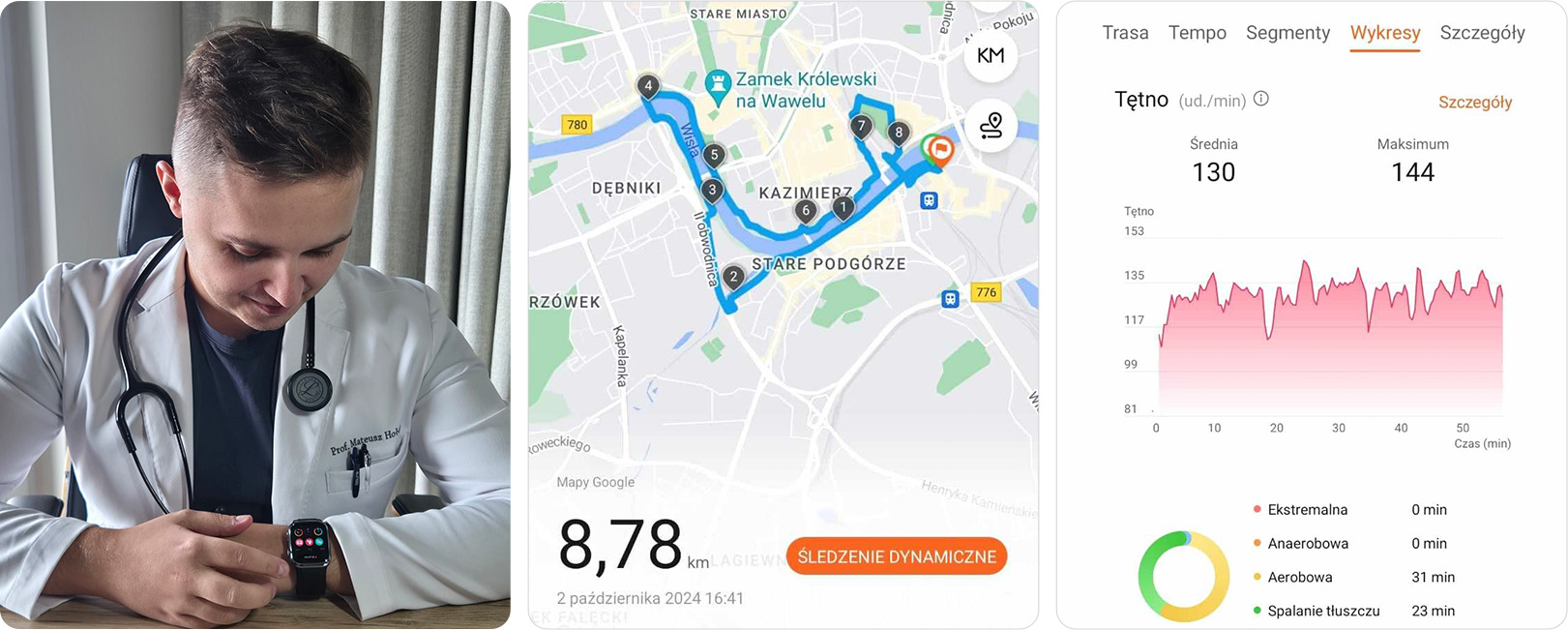Can people with high
blood pressure do exercise?
Exercise Guidelines for
People with High
Blood Pressure

Reading duration: Approximately 5 minutes
Guidelines of the European Society of Cardiology advocate for ≥150 min/week of moderate-intensity aerobic exercise or, alternatively, 75 min/week of vigorous intensity aerobic exercise as a way of reducing blood pressure and risk for cardiovascular disease [2]. It is, however, also important to understand what one must or must not do in relation to exercise and hypertension. This article aims at giving a concise overview, with the purpose of taking you through the dos and don'ts when safely and effectively exercising with hypertension.

Prof. Mateusz Hołda
Prof. Mateusz Hołda is a distinguished professor and medical researcher specializing in cardiovascular anatomy at Jagiellonian University Medical College in Kraków.
He leads the Heart Embryology and Anatomy Research Team (HEART) and also collaborates with the University of Manchester and John Paul II Hospital. Recognized in Forbes' “30 Under 30” in Europe for Science & Healthcare in 2019, he is the youngest professor in Polish history, having achieved the title by age 29.
In this article
What is hypertension?
Is exercise safe for people with high blood pressure?
Exercise principles for people with high blood pressure
How can wearables help you?
Conclusion: exercise as a tool for better cardiovascular health

What is
hypertension?
Before diving into exercise guidelines, let’s define hypertension. Blood pressure is typically categorized as non-elevated, elevated, or hypertensive. A healthy, non-elevated blood pressure reading should be below 120/80 mmHg. Hypertension is defined as having blood pressure readings of 140/90 mmHg or higher. To confirm a diagnosis of hypertension, it is recommended to use out-of-office measurements, such as ambulatory or home blood pressure monitoring, or at least one additional follow-up measurement in a doctor’s office to ensure accuracy [2].
Is exercise safe for people with high blood pressure?
GOOD TO KNOW:
Incorporating other lifestyle modifications, such as adopting a healthy diet, eating regular meals, quitting smoking, reducing salt intake, and achieving weight loss, can further reduce blood pressure.
Regular exercise is not only safe, but also beneficial for most people with high blood pressure. However, in cases of uncontrolled high blood pressure or hypertension, particularly when resting blood pressure is above 200/110 mmHg, high-intensity exercise should be approached with caution, as this level indicates a relative contraindication for physical activity. In all other cases, physical exercise can offer numerous health benefits, including lowering blood pressure and helping to maintain a healthy body weight. Moderate-intensity exercise can reduce systolic blood pressure by 5-8 mmHg, a significant improvement for individuals with hypertension. However, it’s important to approach exercise carefully and carefully follows the advice of your doctor, including consulting your doctor before beginning a new routine [3].
Exercise principles
for people with high blood pressure
Types of exercise
For individuals with high blood pressure, a well-rounded exercise routine is strongly encouraged. The following activities provide a holistic approach to help manage blood pressure and enhance heart health:
o Aerobic exercise: walking, jogging, cycling, or swimming are great choices. They are effective, and natural way to manage and reduce high blood pressure, offering both short-term and long-term cardiovascular benefits.
o Strength training: Resistance exercises like lifting weights are also
beneficial, but focus on low to moderate weights with higher repetitions.
o Flexibility and balance exercises: Activities like yoga or Pilates help reduce stress and improve mobility without putting excess strain on the heart.


Frequency and duration

Consistency is key in increasing the health benefits of exercise. Start with small, achievable goals like 30 minutes of moderate exercise, 5 days a week. If 30 minutes seems too much, break it into three 10-minute sessions throughout the day. Over time, you can increase the duration and intensity of your workouts as your body adapts.
HUAWEI WATCH D2
Ambulatory Blood Pressure Monitoring Precisely manage your health every moment
All-round Health Management
Light and Slim Design
Smart Living Experience Bluetooth calling, music playback and more
Medically Certified
Compatible with iOS and Android

Intensity levels
A moderate intensity level is ideal for people with high blood pressure. To determine your level of exercise intensity, use the talk test: If you can carry on a conversation while exercising but feel slightly breathless, you’re likely at a safe, effective intensity. If moderate activity is tolerated well, you can increase the intensity level of your exercise
If you're new to exercise or have uncontrolled high blood pressure or hypertension, avoid high-intensity exercises, like sprinting or heavy weightlifting, until you consult this type of activity with your doctor.
Monitoring blood pressure during exercise
If you have hypertension, it’s important to monitor your blood pressure regularly both while resting, and during or after exercise.
The best way to do this is by using validated and calibrated home blood pressure monitors or performing 24-hour ambulatory blood pressure monitoring (ABPM). However, this may not always be practical during daily activities. In such cases, enhanced self-monitoring of blood pressure using wearable devices paired with a connected smartphone application can be a practical solution [2].


I strongly recommend that my patients use personal devices that allow for monitoring vital functions during physical exercise. Devices like the HUAWEI WATCH D2, which includes blood pressure monitoring features, can be an excellent tool for tracking your vitals on-the-go.
This approach offers the added benefit of better self-management and real-time control of blood pressure.
How can wearables help you?
The HUAWEI WATCH D2 offers blood pressure measurement to help users understand the effects of exercise on the cardiovascular system. Patients can go over this data for themselves and make accommodations in their workout routine as needed. Remember, these devices support your health journey, but they don't replace clinical-grade blood pressure monitors. The HUAWEI WATCH D2 keeps you within range of what your body responds to from within for a clearer picture of how exercises can affect blood pressure.

Conclusion: exercise as a tool for better cardiovascular health
People with hypertension can and should exercise! Regular physical activity is one of the most effective natural ways to manage blood pressure, strengthen the heart, and enhance overall health. The right exercises that are performed following appropriate recommendations from your doctor will aid in risk-free development of cardiovascular health. Begin with small steps, monitor your progress, and consult your cardiologist for specific advice. Remember, tools like the HUAWEI WATCH D2 really upgrade your fitness journey by keeping track of your vitals and helping you manage your health with so much ease.

Medical disclaimer:
The HUAWEI WATCH D2 is intended to be used by people aged 18 years and over, but is not intended to replace any medical diagnosis or treatment. Data obtained during the use of this device is for personal reference only. Before using the device, please carefully read the Quick Start Guide, Wearing Guide, and Instruction for Use.
Due to national restrictions on obtaining approval / registration as a medical device, the HUAWEI WATCH D2 will only be available in selected European markets.
- Supported smartphones: Mobile phones with Android 6.0 or compatibles, HarmonyOS 2.0 or compatibles, or iOS 12.0 or compatibles. The Huawei Health app version on your mobile phone must be 11.0 or compatibles. Please make sure that your wearable device and phone are running the latest versions before using the device.
[References]
- 1.Kario K et al. (2024): The WHO Global report 2023 on hypertension warning the emerging hypertension burden in globe and its treatment strategy.
- 2.McEvoy JW et al. (2024): 2024 ESC Guidelines for the management of elevated blood pressure and hypertension.
- 3.Pelliccia A et al. (2021): 2020 ESC Guidelines on sports cardiology and exercise in patients with cardiovascular disease.
Administrator
Copied

